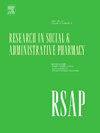The effects of free prescriptions on community pharmacy selection: A discrete choice experiment
IF 3.7
3区 医学
Q1 PUBLIC, ENVIRONMENTAL & OCCUPATIONAL HEALTH
Research in Social & Administrative Pharmacy
Pub Date : 2024-08-24
DOI:10.1016/j.sapharm.2024.08.089
引用次数: 0
Abstract
Background
Little is known about preferences for community pharmacies, particularly the influence of prescription co-payments, and for New Zealand's priority populations, Māori and Pacific Peoples. Improving understanding of community pharmacy preferences will enable tailoring services to meet community needs.
Objectives
This study aims to investigate New Zealanders’ preferences for community pharmacies when collecting prescriptions. Additionally, variations in preferences for community pharmacy attributes between different latent and demographic groups were examined.
Methods
Focus group discussions with various community groups were thematically analyzed to develop six attributes: location, wait time, customer service, prescription co-payments, parking availability, and nearby businesses. Participants were asked to complete an online survey involving 12 choice tasks, where they had to choose their preferred option of 3 unlabeled pharmacies along with demographic questions. A mixed multinomial logit model and latent classes analysis were used to assess and compare the participant preferences.
Results
The sample of 553 participants, representative of the New Zealand population, resulted in 19,908 observations for analysis. The most attractive pharmacy attribute was its proximity, being within a 10-min travel distance from home or work. The importance of prescription co-payments is evident, with free prescriptions being the second most attractive attribute level and $15 NZD prescription co-payments being the least appealing. Different classes placed importance on different attributes, the largest of which prioritized prescription co-payments. Including demographic characteristics did not improve model accuracy nor predict class membership.
Conclusions
Under current policy, the most effective way for pharmacies to attract business is by offering free prescriptions. However, the trend of adopting lower-cost models may reduce the quality of care they deliver. Policy decision-makers must decide if they are comfortable with this potential impact.
免费处方对社区药房选择的影响:离散选择实验。
背景:人们对社区药房的偏好知之甚少,尤其是对处方共付额的影响,以及对新西兰的重点人群--毛利人和太平洋岛屿族裔的偏好。加强对社区药房偏好的了解将有助于提供量身定制的服务以满足社区需求:本研究旨在调查新西兰人在领取处方时对社区药房的偏好。此外,还研究了不同潜在群体和人口群体对社区药房属性偏好的差异:方法:通过对不同社区群体的焦点小组讨论进行主题分析,得出六项属性:地点、等待时间、客户服务、处方共付额、停车位和附近商业。参与者被要求完成一项在线调查,其中包括 12 项选择任务,他们必须在 3 家无标签药店中选择自己喜欢的药店,同时还要回答人口统计学问题。采用混合多项式对数模型和潜类分析来评估和比较参与者的偏好:结果:553 名参与者的样本代表了新西兰的人口,共产生了 19,908 个分析观测值。最有吸引力的药店属性是距离近,离家或上班的距离在 10 分钟以内。处方共付额的重要性显而易见,免费处方是第二吸引人的属性,15 新西兰元的处方共付额是最不吸引人的属性。不同等级对不同属性的重视程度不同,其中最大的等级优先考虑处方共付额。纳入人口统计学特征并不能提高模型的准确性,也不能预测类别成员:在现行政策下,药店吸引顾客的最有效方式是提供免费处方。然而,采用低成本模式的趋势可能会降低其提供的医疗质量。政策决策者必须决定他们是否能接受这种潜在的影响。
本文章由计算机程序翻译,如有差异,请以英文原文为准。
求助全文
约1分钟内获得全文
求助全文
来源期刊

Research in Social & Administrative Pharmacy
PUBLIC, ENVIRONMENTAL & OCCUPATIONAL HEALTH-
CiteScore
7.20
自引率
10.30%
发文量
225
审稿时长
47 days
期刊介绍:
Research in Social and Administrative Pharmacy (RSAP) is a quarterly publication featuring original scientific reports and comprehensive review articles in the social and administrative pharmaceutical sciences. Topics of interest include outcomes evaluation of products, programs, or services; pharmacoepidemiology; medication adherence; direct-to-consumer advertising of prescription medications; disease state management; health systems reform; drug marketing; medication distribution systems such as e-prescribing; web-based pharmaceutical/medical services; drug commerce and re-importation; and health professions workforce issues.
 求助内容:
求助内容: 应助结果提醒方式:
应助结果提醒方式:


